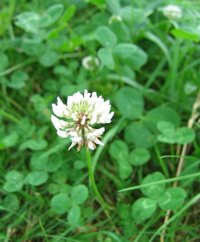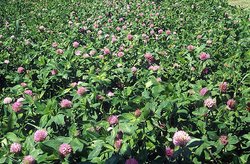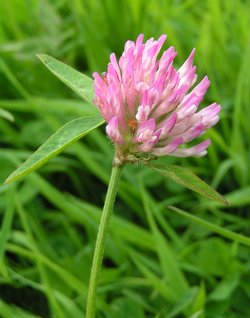Clover
|
|
- For the town, see Clover, South Carolina; for the telescope, see CLOVER array.
| Clover | ||||||||||||
|---|---|---|---|---|---|---|---|---|---|---|---|---|
| Missing image Trefle2.1s.JPG clover flower | ||||||||||||
| Scientific classification | ||||||||||||
| ||||||||||||
| Species | ||||||||||||
|
See text |
Clover (Trifolium) is a genus of about 300 species of plants in the pea family Fabaceae. They are found chiefly in northern temperate regions, but also, like many other north temperate genera, on the mountains in the tropics. The plants are small annual or perennial herbs with trifoliate (rarely 5- or 7-foliate) leaves, with stipules adnate to the leaf-stalk, and heads or dense spikes of small red, purple, white, or rarely yellow flowers; the small, few-seeded pods are enclosed in the calyx. Eighteen species are native in Britain, and several are extensively cultivated as fodder-plants. The most widely cultivated clovers are White clover Trifolium repens and Red clover Trifolium pratense.
Other closely related genera often called clovers include Melilotus (sweet clover) and Medicago (alfalfa or 'calvary clover').
The scientific name derives from the Latin tres, three, and folium, a leaf, so called from the characteristic form of the leaf, which has three leaflets (trifoliate), hence the popular name trefoil. Clovers are used as food plants by the larvae of some Lepidoptera species including Latticed Heath, Garden Dart and Heart and Club.
A common idiom is "to be in clover", meaning to be living a carefree life of ease, comfort, or prosperity.
| Contents |
Cultivation
Clover, either sown alone or in mixture with rye-grass, has for a long time formed the staple crop for soiling; and so long as it grew freely, its power of shooting up again after repeated mowings, the bulk of crop thus obtained, its palatableness to stock and feeding qualities, the great range of soils and climate in which it grows, and its fitness either for pasturage or soiling, well entitled it to this preference. Except on certain rich calcareous clay soils, it has now, however, become an exceedingly precarious crop. The seed, when genuine, which unfortunately is very often not the case, germinates as freely as ever, and no greater difficulty than heretofore is experienced in having a full plant during autumn and the greater part of winter; but over most part of the country, the farmer, after having his hopes raised by seeing a thick cover of vigorous-looking clover plants over his field, finds to his dismay, by March or April, that they have either entirely disappeared, or are found only in capricious patches here and there over the field. No satisfactory explanation of this "clover-sickness" has yet been given, nor any certain remedy, of a kind to be applied to the soil, discovered. However, one important fact is now well established: when the cropping of the land is so managed that clover does not recur at shorter intervals than eight years, it grows with much of its pristine vigour. The knowledge of this fact now determines many farmers in varying their rotation so as to secure this important end. At one time there was a somewhat prevalent belief that the introduction of beans into the rotation had a specific influence of a beneficial kind on the clover when it came next to be sown; but the true explanation seems to be that the beans operate favourably only by the incidental circumstance of almost necessarily lengthening the interval betwixt the recurrences of clover.
Clover sickness may be linked to pollinator decline. Beekeepers are often in heavy demand from farmers with clover pastures, who want bees placed on their farms, as farmers observe the increased reseeding that occurs with increased bee activity.
When a four-course rotation is followed, no better plan of managing this process has been yet suggested than to sow beans, pease, potatoes or tares, instead of clover, for one round, making the rotation one of eight years instead of four. The mechanical condition of the soil seems to have something to do with the success or failure of the clover crop. We have often noticed that headlands, or the converging line of wheel-tracks near a gateway at which the preceding root crop had been carted from a field, have had a good take of clover, when on the field generally it had failed. In the same way a field that has been much poached by sheep while consuming turnips upon it, and which has afterwards been ploughed up in an unkindly state, will have the clover prosper upon it, when it fails in other cases where the soil appears in far better condition. If red clover can be again made a safe crop, it will be a boon indeed to agriculture. Its seeds are usually sown along with a grain crop, any time from 1 February to May.
Italian rye-grass and red clover are frequently sown in mixture for soiling, and succeed admirably. It is, however, a wiser course to sow them separately, as by substituting the Italian rye-grass for clover, for a single rotation, the farmer not only gets a crop of forage as valuable in all respects, but is enabled, if he choose, to prolong the interval betwixt the sowings of clover to twelve years, by sowing, as already recommended, pulse the first round, Italian rye-grass the second, and clover the third.
These two crops, then, are those on which the arable-land farmer mainly relies for green forage. To have them good, he must be prepared to make a liberal application of manure. Good farm-yard dung may be applied with advantage either in autumn or spring, taking care to cart it upon the land only when it is dry enough to admit of this being done without injury. The fertilizer is spread very evenly so soon as emptied from the carts. But it is usually more expedient to use either guano, ammonium nitrate, or soot for this purpose, at the rates respectively of 200 kg/ha, 200 kg/ha and 300 L/ha. If two or more of these substances are used, the quantities of each will be altered in proportion. They are best also to be applied in two or three portions at intervals of fourteen to twenty days, beginning towards the end of December, and only when rain seems imminent or has just fallen.
When manure is broadcast over a young clover field, and presently after washed in by rain, the effect is identical with that of first dissolving it in water, and then distributing the dilution over the surface, with this difference, naniely, that the first plan costs only the price of the guano, etc, and is available at any time and to every one, whereas the latter implies the construction of tanks and costly machinery.
Species
Missing image White_clover_flower.jpg White Clover Flower |
| T. africanum | T. albopurpureum | T. alexandrinum |
| T. amabile | T. ambiguum | T. amoenum |
| T. andersonii | T. andinum | T. angustifolium |
| T. arvense | T. attenuatum | T. aureum |
| T. barbigerum | T. beckwithii | T. bejariense |
| T. bifidum | T. bolanderi | T. brandegeei |
| T. breweri | T. buckwestiorum | T. calcaricum |
| T. campestre | T. carolinianum | T. cernuum |
| T. ciliolatum | T. cyathiferum | T. dalmaticum |
| T. dasyphyllum | T. dedeckerae | T. depauperatum |
| T. dichotomum | T. douglasii | T. dubium |
| T. echinatum | T. eriocephalum | T. fragiferum |
| T. friscanum | T. fucatum | T. glomeratum |
| T. gracilentum | T. gymnocarpon | T. haydenii |
| T. hirtum | T. howellii | T. hybridum |
| T. incarnatum | T. jokerstii | T. kingii |
| T. lappaceum | T. latifolium | T. leibergii |
| T. lemmonii | T. longipes | T. lupinaster |
| T. macraei | T. macrocephalum | T. medium |
| T. michelianum | T. microcephalum | T. microdon |
| T. minutissimum | T. monanthum | T. mucronatum |
| T. nanum | T. neurophyllum | T. nigrescens |
| T. obtusiflorum | T. oliganthum | T. olivaceum |
| T. ornithopodioides | T. owyheense | T. parryi |
| T. pinetorum | T. plumosum | T. polymorphum |
| T. pratense | T. productum | T. purpureum |
| T. pygmaeum | T. reflexum | T. repens |
| T. resupinatum | T. rollinsii | T. rueppellianum |
| T. scabrum | T. semipilosum | T. siskiyouense |
| T. spumosum | T. squamosum | T. stoloniferum |
| T. striatum | T. subterraneum | T. suffocatum |
| T. thompsonii | T. tomentosum | T. trichocalyx |
| T. uniflorum | T. variegatum | T. vesiculosum |
| T. virginicum | T. willdenowii | T. wormskioldii |
| Ref: ITIS 26204 (http://www.itis.usda.gov/servlet/SingleRpt/SingleRpt?search_topic=TSN&search_value=26204) as of 2002-07-31 | ||
T. incarnatum, Crimson or Italian clover, though not hardy enough to withstand the climate of Scotland in ordinary winters, is a most valuable forage crop in England. It is sown as quickly as possible after the removal of a grain crop at the rate of 20-22 kg/ha. It is found to succeed better when only the surface of the soil is stirred by the scarifier and harrow than when a ploughing i1 given. It grows rapidly in spring, and yields an abundant crop of green food, peculiarly palatable to live stock. It is also suitable for making into hay. Only one cutting, however, can be obtained, as it does not shoot again after being mown.
T. repens, White or Dutch clover, is a perennial abundant in meadows and good pastures. The flowers are white or pinkish, becoming brown and deflexed as the corolla fades. T. hybridum, Alsike or Swedish clover, is a perennial which was introduced early in the 19th century and has now become naturalized in Britain. The flowers are white or rosy, and resemble those of the last species. T. medium, meadow or zigzag clover, a perennial with straggling flexuous stems and rose-purple flowers, is of little agricultural value. Other British species are: T. arvense, Hare's-foot trefoil; found in fields and dry pastures, a soft hairy plant with minute white or pale pink flowers and feathery sepals; T. fragiferum, Strawberry clover, with denselyflowered, globose, rose-purple heads and swollen calyxes; T. procumbens, Hop trefoil, on dry pastures and roadsides, the heads of pale yellow flowers suggesting miniature hops; and the somewhat similar T. minus, common in pastures and roadsides, with smaller heads and small yellow flowers turning dark brown. The last named is often called Shamrock. Specimens of shamrock and other clovers are not infrequently found with four leaflets, and, like other rarities, are considered lucky.
Uses
Clovers are a valuable survival food. High in protein, widespread, and abundant. They are not easy to digest raw, but this can be easily fixed by boiling for 5-10 minutes. Dried flowerheads and seedpods can also be ground up into a nutritious flour and mixed with other foods. Dried flowerheads also steeped in hot water for a healthy, tasty tea.



